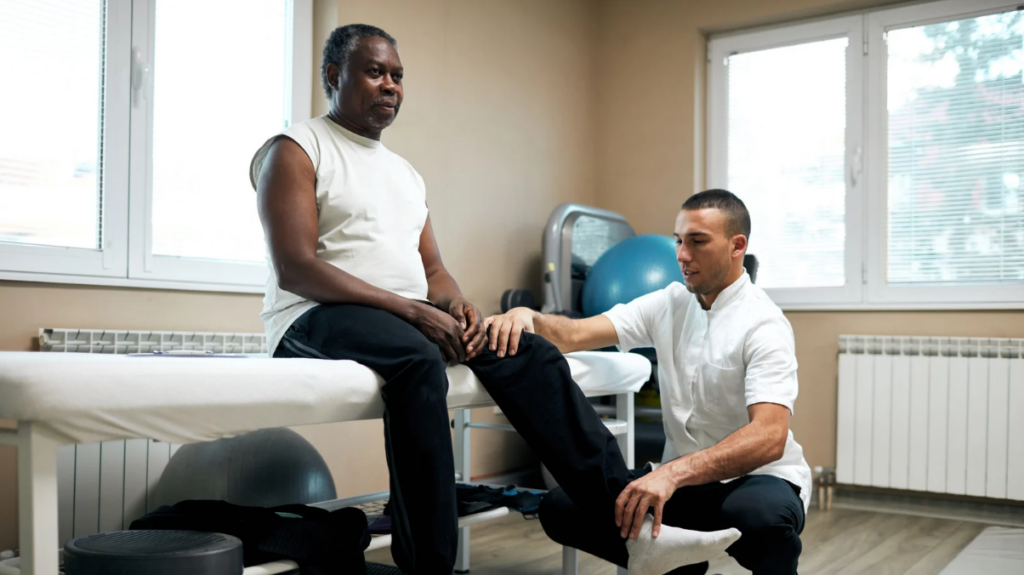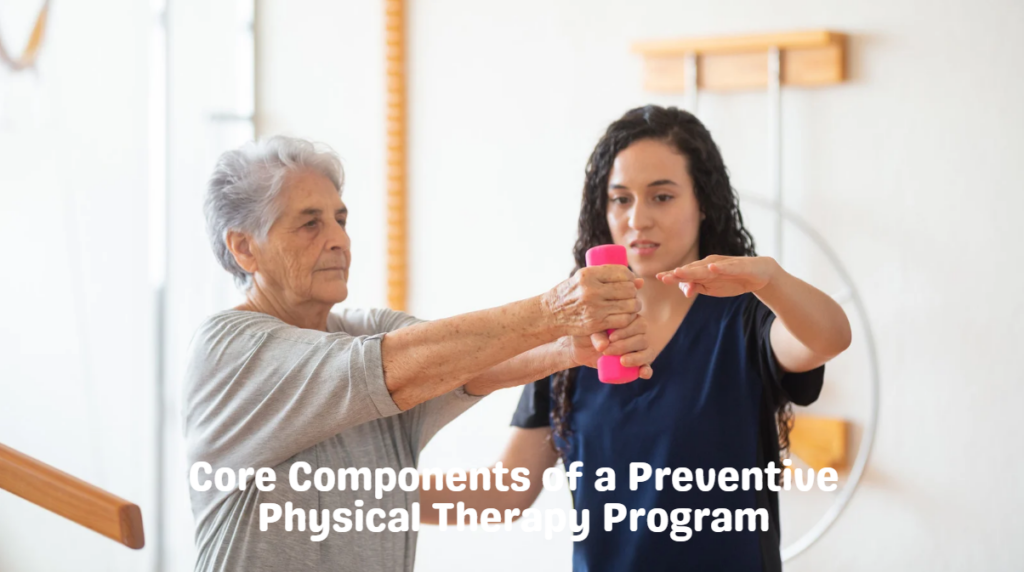When most people hear the words physical therapy, they picture rehabilitation — treatment after surgery, injury, or chronic pain. But physical therapy is far more than a response to damage. It’s one of the most powerful forms of preventive care available in modern healthcare.
Pain is often the final warning sign, not the beginning. Long before discomfort or immobility occurs, the body gives subtle cues — stiffness, weakness, fatigue, or poor posture. Physical therapists are trained to interpret these signs and intervene early, preventing small dysfunctions from becoming painful, debilitating conditions.
The true goal of physical therapy is not just to help you recover, but to help you avoid injury altogether. Physical therapy for injury prevention focuses on identifying imbalances, correcting movement patterns, and teaching efficient mechanics so you can stay active, strong, and pain-free. In essence, it builds a foundation for lifelong mobility and physical resilience.
Physical Therapy Beyond Recovery
Physical therapy extends far beyond post-injury care. It is a science-driven discipline centered on movement — the way the body balances, stabilizes, and interacts with its environment. Therapists analyze posture, strength, flexibility, and joint mobility to determine how well the body performs under everyday demands.
At its core, physical therapy focuses on functional movement optimization. This means ensuring that every muscle and joint operates in harmony with the rest of the body. It’s not only about treating pain but understanding why pain develops in the first place — and stopping it before it starts.
Physical therapists are experts in biomechanics — the science of how we move. They observe and correct even the smallest deviations from ideal movement, which can have a profound impact on performance and longevity. This proactive approach helps individuals—from athletes to office workers—prevent injuries that stem from repetitive strain, poor posture, or muscle imbalance.
By re-educating the body to move correctly, physical therapy helps create long-term stability, improved coordination, and greater overall wellness.
How Injuries Begin Before Pain Appears

Most injuries are not sudden or accidental; they are cumulative. Over time, repetitive motions, improper posture, and limited flexibility lead to microscopic stresses on muscles, joints, and ligaments. These stresses build up slowly, creating dysfunction long before pain signals the problem.
For instance, a slight imbalance in hip alignment can eventually cause knee pain. Tight hamstrings might pull on the lower back, leading to chronic stiffness. Even something as simple as sitting incorrectly for hours each day can cause a chain reaction of strain across multiple body regions.
The body is designed to compensate for weakness or tightness. When one area becomes inefficient, another takes over its workload. This short-term adaptation may seem harmless, but over time, it leads to fatigue, poor mechanics, and eventually injury.
Physical therapy interrupts this process early. By assessing subtle asymmetries, restricted movement, or weakness, therapists identify the root cause of dysfunction before pain develops. This preventive focus allows patients to maintain optimal movement quality, ensuring every part of the body performs as it should.
The Real Power of Physical Therapy for Injury Prevention
The foundation of preventive physical therapy lies in understanding the body’s movement system as an interconnected chain. Every joint, muscle, and ligament contributes to stability and mobility. When one link weakens, the entire chain becomes vulnerable.
Physical therapists perform comprehensive movement analyses that reveal inefficiencies in balance, flexibility, and strength. They evaluate gait, posture, and coordination using evidence-based tools such as functional movement screens and range-of-motion assessments. These evaluations provide measurable insights into how well your body performs — and where it’s at risk.
Preventive PT focuses heavily on neuromuscular re-education, which enhances the brain’s ability to control movement efficiently. This process refines balance, timing, and coordination, ensuring that muscles activate properly during daily tasks and exercise. The result is greater body control, improved performance, and significantly reduced injury risk.
Additionally, physical therapy promotes movement efficiency — the art of performing actions with minimal strain. By improving joint alignment, flexibility, and muscular balance, PT helps distribute physical loads evenly, protecting the body from excessive wear and tear.
In short, preventive PT trains your body to function in its most natural, efficient state — preventing pain before it ever has a chance to appear.
The Benefits of Early Physical Therapy Intervention

Early physical therapy intervention helps prevent minor issues from developing into chronic conditions, promoting faster recovery and long-term mobility.
1. Detecting Weakness and Imbalance Before Injury
Through precise evaluation, physical therapy identifies areas of weakness, stiffness, or instability that could later cause injury. Strengthening weak muscles and correcting imbalances restores harmony across the musculoskeletal system, helping the body move more efficiently and safely.
2. Enhancing Movement Quality and Athletic Performance
Whether you’re a professional athlete or a weekend jogger, optimal movement patterns are key to performance. PT refines the way your body transfers force and absorbs impact, allowing smoother, more powerful motion while minimizing the risk of overuse injuries.
3. Promoting Better Posture and Ergonomics
Poor posture is one of the most common causes of chronic pain and tension. Physical therapists teach proper alignment while sitting, standing, or lifting — and provide ergonomic strategies for your workspace or home setup. The result is less strain and greater comfort throughout the day.
4. Increasing Body Awareness and Confidence
Preventive PT encourages individuals to understand their body’s limits and capabilities. This awareness allows for safer exercise, improved coordination, and confidence in physical activities — from sports to daily movement.
5. Saving Time, Pain, and Long-Term Costs
Investing in prevention saves both physical and financial resources. Addressing dysfunction early reduces the likelihood of costly medical procedures, time-consuming rehabilitation, and prolonged discomfort. Prevention is not an expense; it’s an investment in lifelong mobility and health.
Core Components of a Preventive Physical Therapy Program

A preventive physical therapy program focuses on proactive strategies—such as strength training, posture correction, and movement education—to reduce injury risk and enhance overall function.
1. Comprehensive Movement Evaluation
Every preventive PT plan begins with a detailed full-body assessment. Therapists evaluate range of motion, flexibility, balance, and joint stability. This process identifies weaknesses or restrictions that could lead to pain or injury later.
2. Personalized Exercise Prescription
Once imbalances are identified, a customized exercise program is created. This may include corrective strengthening, mobility drills, flexibility routines, and balance training. The goal is to restore muscular symmetry and joint efficiency tailored to each person’s needs and lifestyle.
3. Manual Therapy and Soft Tissue Interventions
Hands-on techniques such as myofascial release, stretching, and joint mobilization help improve circulation, release tension, and restore normal joint movement. These therapies complement exercise interventions, ensuring smoother and pain-free motion.
4. Postural and Ergonomic Education
A vital part of prevention is learning how to maintain proper posture throughout the day. Physical therapists provide individualized instruction on lifting mechanics, workstation setup, and everyday movement patterns that reduce unnecessary stress on the body.
5. Lifestyle and Movement Coaching
Physical therapists don’t just address the body — they guide long-term habits. Education on stretching routines, warm-up and cooldown practices, and rest management promotes recovery and overall wellness. Patients learn to balance activity and recovery for sustainable health.
6. Periodic Reassessment and Maintenance
Preventive care is an ongoing journey. Regular follow-ups allow therapists to adjust programs as your body evolves. These check-ins ensure continuous improvement and help you adapt to new physical challenges safely.
Populations That Benefit Most from Preventive PT

Preventive physical therapy offers significant advantages for individuals of all ages, especially those at higher risk for injury, chronic pain, or age-related mobility decline.
Athletes and Active Individuals
Athletes put their bodies under constant stress. Preventive PT enhances performance, refines mechanics, and lowers the risk of overuse injuries by ensuring muscles and joints work in perfect synergy.
Office Workers and Sedentary Professionals
Spending hours sitting can weaken core muscles and tighten the hips and shoulders. Preventive therapy corrects these issues, improving posture and reducing chronic tension and fatigue.
Older Adults
As people age, muscle mass, balance, and flexibility naturally decline. Preventive PT helps maintain strength, mobility, and coordination — reducing fall risk and promoting independence.
Postpartum and Prehabilitation Patients
Women recovering from childbirth and individuals preparing for surgery benefit from PT’s emphasis on core stability, alignment, and controlled strength. It ensures safer recovery and reduces the risk of future injury.
Youth and Teen Athletes
Developing bodies are especially vulnerable to imbalance and poor technique. Preventive PT ensures young athletes build proper mechanics early, supporting healthy growth and long-term performance.
Integrating Preventive Physical Therapy into Daily Life

The most effective way to benefit from physical therapy is to make it part of your ongoing health maintenance, not a last resort when pain appears. Just as you schedule annual checkups with your doctor or dentist, incorporating regular movement assessments with a physical therapist can protect your musculoskeletal health for the long term.
Here are proactive steps to integrate PT into everyday life:
- Schedule Regular Assessments: Visit your physical therapist at least once or twice a year for a movement and posture evaluation.
- Stay Consistent with Exercises: Integrate your prescribed stretches and strength exercises into your weekly routine.
- Prioritize Mobility: Dedicate a few minutes daily to gentle stretching and joint mobility to maintain flexibility.
- Apply Ergonomic Habits: Adjust your workspace and daily movements to reduce unnecessary strain.
- Listen to Early Signs: Fatigue, tightness, or reduced flexibility are cues to seek professional guidance before they evolve into pain.
These simple, consistent habits help ensure your body remains balanced and resilient, regardless of your lifestyle or age.
Final Thoughts
Physical therapy isn’t just about recovery — it’s about prevention, performance, and longevity. By improving body mechanics and correcting dysfunctions before they cause pain, PT helps you stay strong, mobile, and confident. The true power of physical therapy lies not only in pain relief but in the freedom and assurance that your body can move safely and efficiently. Pain shouldn’t be the starting point for care. When you move well, you thrive — and that’s the real power of physical therapy: preventing injury and unlocking your full potential before pain even starts.
Genezen Home Health Care offers trusted, professional physical therapy designed to keep you moving well and living pain-free. Their licensed therapists take a proactive approach—identifying risks, enhancing mobility, and guiding you toward lasting physical wellness. Each care plan is personalized to your goals and needs, ensuring expert support and education every step of the way. Known for reliability, compassion, and patient-centered care, Genezen Home Health Care helps you build strength, restore confidence, and live with ease. Trust their team to help you stay strong, balanced, and injury-free. Contact us today.


